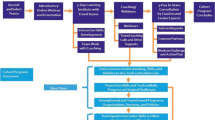Abstract
The Systemic Change Model for Leadership, Inclusion, and Mentoring (SLIM) concentrates on systemic changes occurring in child care organizations where the director builds caring, consistent relationships with the total system and empowers the staff and others through leadership. The model recognizes the importance of focusing on system changes by the organization's director. Leadership qualities related to concepts used in business organizations are included in the training. A mentoring program will help the director focus on his or her leadership capabilities in moving the organization to change. An important collaboration component of the model is working with inclusion of children with special needs. Included in the model are: collaboration components, systemic change, director leadership role, business model related to child care, mentoring, and inclusion of children with special needs.
Similar content being viewed by others
REFERENCES
Blank, H., Adams, G., & Schulman, K. (1999). Child care. In S. Martinez (Ed.), The state of America's children yearbook, p. 53. Washington, DC: Children's Defense Fund.
Bredekamp, S., Knuth, R. A., Kunesh, L. G., & Shulman, D. D. (1992). What does research say about early childhood education?Oak Brook, IL: National Central Regional Educational Laboratory (NCREL).
Bruder, M. B. (2001). Early intervention for children with disabilities. Unpublished doctoral dissertation, University of Connecticut, School of Medicine, Child and Family Studies, Storrs, CT.
Casper, L. M., Hawkins, M., & O'Connell, M. (1994). Who's minding the kids: Child care arrangements Government Printing Office Current Population Reports. P. 70-36. Washington, DC: Bureau of the Census.
Kouzes, J. M., & Posner, B. Z. (1995). The leadership challenge: How to keep getting extraordinary things done in organizations. San Francisco, CA: Jossey-Bass Publishers.
Love, M. (2000). Changing a child care system through leadership and environment. Unpublished Ph.D. dissertation. The Union Institute University, Cincinnati, OH.
Martinez, S., Kozarsky, G., & Tindell, K. (Eds.). (1999). The state of America's children. Washington, DC: Children's Defense Fund.
Shore, R. (1997). Rethinking the brain: New insights into early development. New York: Families and Work Institute.
Tergesen, A. (1999). Avoiding the day care nightmare. Business Week, Oct. 18, 1999, 211–212.
Udell, T., Peters, J., & Templeman, T. P. (1998). Inclusive early childhood programs. Teaching Exceptional Children, 30(3), 44–48.
Author information
Authors and Affiliations
Corresponding author
Rights and permissions
About this article
Cite this article
Fleming, J., Love, M. A Systemic Change Model for Leadership, Inclusion, and Mentoring (SLIM). Early Childhood Education Journal 31, 53–57 (2003). https://doi.org/10.1023/A:1025188819506
Issue Date:
DOI: https://doi.org/10.1023/A:1025188819506




